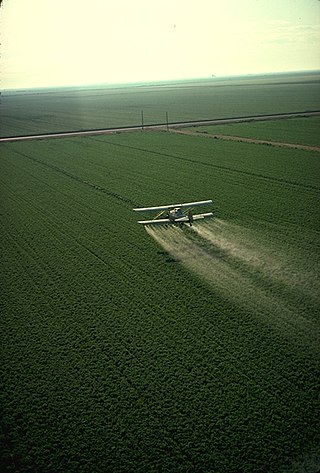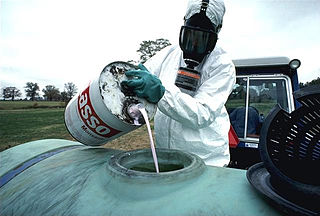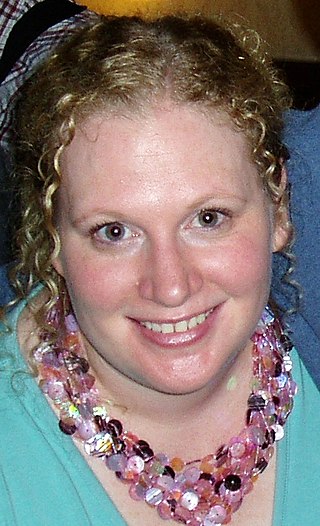
Pesticides are substances that are meant to control pests. This includes herbicide,insecticide,nematicide,molluscicide,piscicide,avicide,rodenticide,bactericide,insect repellent,animal repellent,microbicide,fungicide,and lampricide. The most common of these are herbicides,which account for approximately 50% of all pesticide use globally. Most pesticides are intended to serve as plant protection products,which in general,protect plants from weeds,fungi,or insects. As an example,the fungus Alternaria solani is used to combat the aquatic weed Salvinia.

Silent Spring is an environmental science book by Rachel Carson. Published on September 27,1962,the book documented the environmental harm caused by the indiscriminate use of pesticides. Carson accused the chemical industry of spreading disinformation,and public officials of accepting the industry's marketing claims unquestioningly.

Insecticides are substances used to kill insects. They include ovicides and larvicides used against insect eggs and larvae,respectively. Insecticides are used in agriculture,medicine,industry and by consumers. Insecticides are claimed to be a major factor behind the increase in the 20th-century's agricultural productivity. Nearly all insecticides have the potential to significantly alter ecosystems;many are toxic to humans and/or animals;some become concentrated as they spread along the food chain.

Imidacloprid is a systemic insecticide belonging to a class of chemicals called the neonicotinoids which act on the central nervous system of insects. The chemical works by interfering with the transmission of stimuli in the insect nervous system. Specifically,it causes a blockage of the nicotinergic neuronal pathway. By blocking nicotinic acetylcholine receptors,imidacloprid prevents acetylcholine from transmitting impulses between nerves,resulting in the insect's paralysis and eventual death. It is effective on contact and via stomach action. Because imidacloprid binds much more strongly to insect neuron receptors than to mammal neuron receptors,this insecticide is more toxic to insects than to mammals.
Pesticides vary in their effects on bees. Contact pesticides are usually sprayed on plants and can kill bees when they crawl over sprayed surfaces of plants or other areas around it. Systemic pesticides,on the other hand,are usually incorporated into the soil or onto seeds and move up into the stem,leaves,nectar,and pollen of plants.
Neonicotinoids are a class of neuro-active insecticides chemically similar to nicotine,developed by scientists at Shell and Bayer in the 1980s.

The environmental effects of pesticides describe the broad series of consequences of using pesticides. The unintended consequences of pesticides is one of the main drivers of the negative impact of modern industrial agriculture on the environment. Pesticides,because they are toxic chemicals meant to kill pest species,can affect non-target species,such as plants,animals and humans. Over 98% of sprayed insecticides and 95% of herbicides reach a destination other than their target species,because they are sprayed or spread across entire agricultural fields. Other agrochemicals,such as fertilizers,can also have negative effects on the environment.

Clothianidin is an insecticide developed by Takeda Chemical Industries and Bayer AG. Similar to thiamethoxam and imidacloprid,it is a neonicotinoid. Neonicotinoids are a class of insecticides that are chemically similar to nicotine,which has been used as a pesticide since the late 1700s. Clothianidin and other neonicotinoids act on the central nervous system of insects as an agonist of nAChR,the same receptor as acetylcholine,the neurotransmitter that stimulates and activating post-synaptic acetylcholine receptors but not inhibiting AChE. Clothianidin and other neonicotinoids were developed to last longer than nicotine,which is more toxic and which breaks down too quickly in the environment. However,studies published in 2012 show that neonicotinoid dust released at planting time may persist in nearby fields for several years and be taken up into non-target plants,which are then foraged by bees,caterpillars,and other insects.

Colony collapse disorder (CCD) is an abnormal phenomenon that occurs when the majority of worker bees in a honey bee colony disappear,leaving behind a queen,plenty of food,and a few nurse bees to care for the remaining immature bees. While such disappearances have occurred sporadically throughout the history of apiculture,and have been known by various names,the syndrome was renamed colony collapse disorder in early 2007 in conjunction with a drastic rise in reports of disappearances of western honey bee colonies in North America. Beekeepers in most European countries had observed a similar phenomenon since 1998,especially in Southern and Western Europe;the Northern Ireland Assembly received reports of a decline greater than 50%. The phenomenon became more global when it affected some Asian and African countries as well.

Acetamiprid is an organic compound with the chemical formula C10H11ClN4. It is an odorless neonicotinoid insecticide produced under the trade names Assail,and Chipco by Aventis CropSciences. It is systemic and intended to control sucking insects (Thysanoptera,Hemiptera,mainly aphids) on crops such as leafy vegetables,citrus fruits,pome fruits,grapes,cotton,cole crops,and ornamental plants. It is also a key pesticide in commercial cherry farming due to its effectiveness against the larvae of the cherry fruit fly.

Health effects of pesticides may be acute or delayed in those who are exposed. Acute effects can include pesticide poisoning,which may be a medical emergency. Strong evidence exists for other,long-term negative health outcomes from pesticide exposure including birth defects,fetal death,neurodevelopmental disorder,cancer,and neurologic illness including Parkinson's disease. Toxicity of pesticides depend on the type of chemical,route of exposure,dosage,and timing of exposure.

Thiamethoxam is the ISO common name for a mixture of cis-trans isomers used as a systemic insecticide of the neonicotinoid class. It has a broad spectrum of activity against many types of insects and can be used as a seed dressing.

Thiacloprid is an insecticide of the neonicotinoid class. Its mechanism of action is similar to other neonicotinoids and involves disruption of the insect's nervous system by stimulating nicotinic acetylcholine receptors. Thiacloprid was developed by Bayer CropScience for use on agricultural crops to control of a variety of sucking and chewing insects,primarily aphids and whiteflies.

Sulfoxaflor,also marketed as Isoclast,is a systemic insecticide that acts as an insect neurotoxin. A pyridine and a trifluoromethyl compound,it is a member of a class of chemicals called sulfoximines,which act on the central nervous system of insects.
Bridget J. Stutchbury is a Canadian biologist,currently a Distinguished Research Professor and Canada Research Chair in Ecology and Conservation Biology at York University. She is the author of the book Silence of the Songbirds,finalist for the 2007 Governor General's Award for Non-fiction.
The Cannabinoid Research Initiative of Saskatchewan (CRIS) was founded in 2017 as an interdisciplinary research team of clinician researchers (medical and veterinary),basic scientists,and social scientists. CRIS aims to obtain scientific evidence about the application of Cannabinoids and Medical cannabis to humans and animals,for health,disease and disorders. The team was initially based at the University of Saskatchewan,in Saskatoon,Saskatchewan,Canada but includes researchers based at the University of Regina and University of Alberta. A strategic management executive committee coordinates activities and develops research opportunities. The sections of CRIS include:Analytical Evaluations,Human Clinical Studies,Biomedical studies,Veterinary Sciences,Knowledge Translation and Studies of Cannabinoids and Society. CRIS members participate in the Canadian Consortium for the Investigation of Cannabinoids,and the International Cannabinoid Research Society.
Valerie Joyce Korinek is a Canadian historian. She is a professor of history at the University of Saskatchewan and a Fellow of the Royal Society of Canada. Her research focuses on Queer studies and communities.
Ingrid Jane Pickering is a geoscientist. She is a professor and Canada Research Chair in Molecular Environmental Science at the University of Saskatchewan. In 2018,Pickering was the first woman appointed Chair of the Canada Foundation for Innovation Board of Directors.

Regan Lee Mandryk is a Professor of Computer Science at the University of Saskatchewan. She specializes in Human-computer interaction.
Erika Ellen Dyck is a Canadian historian. She is a professor of history and Canada Research Chair in the History of Medicine at the University of Saskatchewan. In 2014,Dyck was inducted to the New College of Scholars,Artists and Scientists at the Royal Society of Canada.














